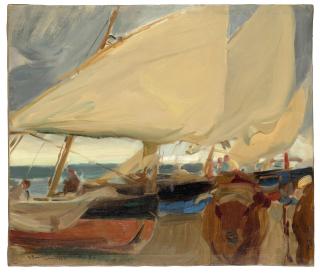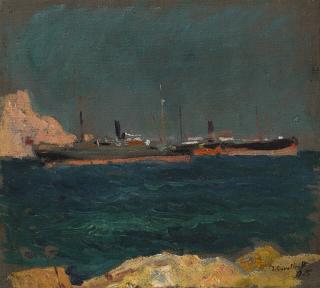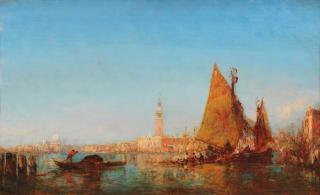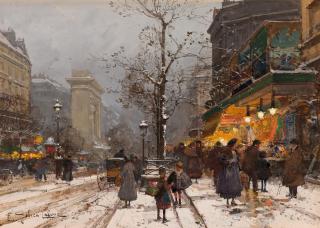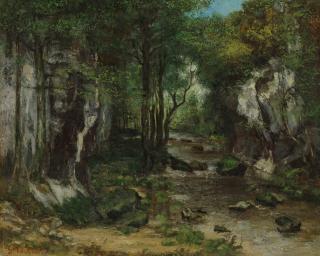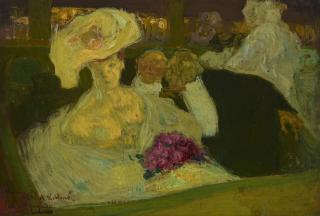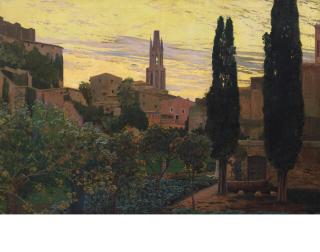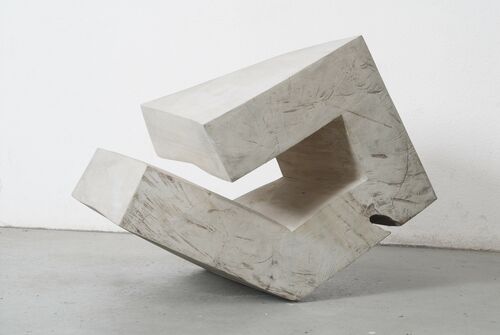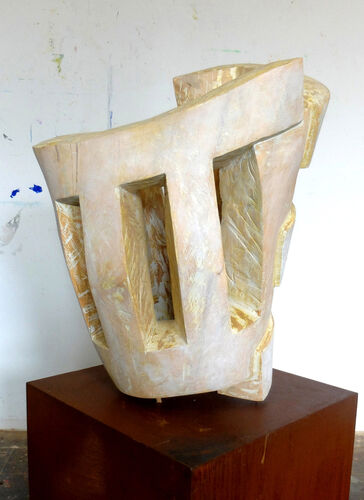Joaquín Sorolla y Bastida Valencia 1863 - 1923 near Madrid
The artist Joaquín Sorolla y Bastida
- Spanish painter of impressionism and realism.
- Combined social themes with extraordinary depiction of light.
- Considered the most successful artist around 1900.
At the age of nine, Joaquín Sorolla y Bastida began an artistic apprenticeship in addition to his actual training as a locksmith. The director of his crafts school had recognized the extraordinary talent and convinced Sorolla's relatives, with whom he grew up, of this. Born in Valencia in 1863, Sorolla was orphaned at the age of two. At 18, he traveled to Madrid to copy paintings in the Prado, then a few years later to Rome on a scholarship that lasted several years. Sorolla also visited Paris, where he first saw Impressionist paintings that had a lasting influence on his own work.
In 1888, Sorolla returned to Spain and lived most of the time in Madrid with his wife and three children. The painter gradually turned to realism, which he combined with stylistic elements and the open-air painting of Impressionism. He bathed his historical and social subjects as well as portraits and genre paintings in a unique light that fascinated his contemporaries. Unusual perspectives also contributed to the singular character of his works. Sewing the Sail (1896), Sad Inheritance! (1899) and The Horse's Bath (1909) are just a few examples of his celebrated paintings.
Sorolla achieved one success after another from 1890: He participated in countless national and international exhibitions and won more prizes than any painter before him. Among others, he received a gold medal and the first prize at the Chicago International Exhibition in Madrid in 1892, a gold medal at the International Art Exhibition in Berlin in 1896, a medal of honor at the World's Fair in Paris in 1900 and another one in Madrid a year later. The solo exhibitions dedicated to him, such as the one in Paris with about 450 paintings on display, went beyond all known dimensions and attracted record numbers of visitors both in Europe and in the United States.
The artist devoted himself to open-air painting in all weathers, which over time took its toll on his health. In 1923, at the age of 60, he died a very wealthy and also the most famous painter of his time. After his death, his wife bequeathed many of Sorolla's paintings to the Spanish state. These formed the basis for the Museo Sorolla, which opened in 1932 and is located in the artist's former home.
Der Künstler Joaquín Sorolla y Bastida
- Spanischer Maler des Impressionismus und Realismus.
- Vereinte soziale Themen mit außergewöhnlicher Darstellung des Lichts.
- Gilt als erfolgreichster Künstler um 1900.
Bereits im Alter von neun Jahren begann Joaquín Sorolla y Bastida neben seiner eigentlichen Ausbildung zum Schlosser eine künstlerische. Der Direktor seiner Handwerksschule hatte das außergewöhnliche Talent erkannt und Sorollas Verwandte, bei denen er aufwuchs, davon überzeugt. Der 1863 in Valencia geborene Sorolla war schon mit zwei Jahren Vollwaise. Mit 18 reiste er nach Madrid, um im Prado Gemälde zu kopieren, einige Jahre später im Rahmen eines mehrjährigen Stipendiums dann nach Rom. Sorolla besuchte auch Paris, wo er erstmals impressionistische Gemälde sah, die seine eigene Tätigkeit nachhaltig beeinflussten.
Im Jahr 1888 kehrte Sorolla nach Spanien zurück und lebte mit seiner Frau und seinen drei Kindern die meiste Zeit in Madrid. Der Maler wandte sich nach und nach dem Realismus zu, den er mit Stilelementen und der Freilichtmalerei des Impressionismus verband. Seine historischen und sozialen Themen sowie Porträts und Genrebilder tauchte er in ein einzigartiges Licht, das seine Zeitgenossen faszinierte. Auch ungewöhnliche Perspektiven trugen zum Alleinstellungsmerkmal seiner Arbeiten bei. Das Nähen des Segels (1896), Trauriges Erbe! (1899) und Das Bad des Pferdes (1909) sind nur einige Beispiele seiner gefeierten Gemälde.
Sorolla erzielte ab 1890 einen Erfolg nach dem anderen: Er nahm an unzähligen nationalen und internationalen Ausstellungen teil und gewann so viele Preise wie kein Maler vor ihm. So erhielt er unter anderem 1892 in Madrid eine Goldmedaille und den ersten Preis der Chicago International Exhibition, 1896 eine Goldmedaille auf der Internationalen Kunstausstellung in Berlin, 1900 eine Ehrenmedaille auf der Weltausstellung in Paris und ein Jahr später eine weitere in Madrid. Die ihm gewidmeten Einzelausstellungen, wie die in Paris mit circa 450 ausgestellten Gemälden, sprengten alle bekannten Dimensionen und lockten sowohl in Europa als auch in den USA Besucherrekordzahlen an.
Der Künstler verschrieb sich bei jedem Wetter der Freilichtmalerei, was seiner Gesundheit im Laufe der Zeit schwer zusetzte. 1923 verstarb er im Alter von 60 Jahren 1923 als sehr reicher und außerdem berühmtester Maler seiner Zeit. Nach seinem Tod vermachte seine Ehefrau dem spanischen Staat viele von Sorollas Gemälden. Diese bildeten die Grundlage für das Museo Sorolla, das 1932 eröffnete und sich im ehemaligen Wohnhaus des Künstlers befindet.
Joaquín Sorolla y Bastida in a nutshell
Joaquín Sorolla y Batista was born in Valencia on February 27, 1863. The house where he was born was near his parents' weaving mill, at Calle de las Mantas No. 8, in the center of the city. A ceramic plaque on the wall of the building that stands there today commemorates Sorolla.
Among the most important features of Joaquín Sorolla's paintings is his masterful ability to capture the play of light and color. He was exceptionally good at depicting the effects of natural sunlight, especially in his outdoor scenes and beach landscapes. Even famous painters like Claude Monet were impressed by Sorolla's skills. Sorolla's brushwork and coloring were imbued with a sense of energy and vitality, evoking the warmth and glow of Spanish sunlight. His innovative approach to capturing light not only added depth and dimension to his paintings, but also created a sense of atmosphere and an enhanced sensory experience for the viewer.
Sorolla's paintings are characterized by a captivating realism that is matched by an expressive and spontaneous quality. His subjects, whether landscapes, seascapes, portraits, or genre scenes, were rendered with extraordinary detail and precision. Yet his brushwork was loose and fluid, giving life and movement to his compositions. Sorolla's ability to capture the fleeting moments of everyday life with spontaneity and authenticity contributed to the dynamism of his art.
Through his art, Sorolla celebrated the beauty of human life and the diverse cultural traditions of Spain. He depicted scenes of people at work, leisure, and in various social contexts, capturing the nuances of their expressions, gestures, and interactions. Whether it was fishermen by the sea, women in traditional costumes, or children playing on the beach, Sorolla's paintings conveyed a sense of joy, vitality, and the richness of the human experience.
Sorolla's paintings are coveted by collectors and are therefore scattered in many private collections from all over the world.But numerous museums have also secured works by the painter.A central place to go is the Museo Sorolla in Madrid. It opened in 1932 after Sorolla's widow donated many of her husband's paintings to the Spanish state. The Museo de Bellas Artes in Valencia, Sorolla's birthplace, also houses a large number of his paintings. Other paintings can be found, for example, at the Prado in Madrid, the Taft Museum of Art in Cincinnati, Ohio, the Philadelphia Museum of Art, and the Metropolitan Museum of Art.
Of particular importance is Sorolla's large late work: 14 frescoes with a total length of almost 30 meters. He executed the commissioned Vision of Spain between 1913 and 1919 for the Hispanic Society of America in New York, which now serves as a museum.
Valencia Joaquín Sorolla station is one of the two main stations in Valencia. It opened in 2010 and is named after Sorolla, who was born in Valencia and is one of the most famous Spanish painters of all time. The station is to be replaced by a new central station, but the project has been delayed repeatedly for years (as of July 2023).
Sorolla died in 1923 in the village of Cercedilla near Madrid. However, he was buried in the Cemeteri de Valencia in his native city.
Sorolla produced an estimated 4,000 oil paintings and watercolors. The medium and size of the work also determine the price, which varies from about $30,000 to over $1 million. Most paintings, however, fetch prices between $100,000 and $500,000. The most expensive work in our databases to date is Pescadores Valencianos from 1895, which fetched just over 3.7 million British pounds ($5.9 million) at a Sotheby's auction in 2012.
Häufige Fragen zu Joaquín Sorolla y Bastida
Joaquín Sorolla y Batisda kam am 27. Februar 1863 in Valencia zur Welt. Das Geburtshaus lag in der Nähe der Weberei seiner Eltern, in der Calle de las Mantas Nr. 8, im Zentrum der Stadt. Eine Keramiktafel an der Wand des heute dort stehenden Gebäudes erinnert an Sorolla.
Eines der wichtigsten Merkmale der Gemälde von Joaquín Sorolla ist seine meisterhafte Fähigkeit, das Spiel von Licht und Farbe einzufangen. Er verstand es außerordentlich gut, die Wirkung des natürlichen Sonnenlichts darzustellen, vor allem in seinen Außenaufnahmen und Strandlandschaften. Selbst berühmte Maler wie Claude Monet waren von Sorollas Fähigkeiten beeindruckt. Sorollas Pinselführung und Farbgebung waren von einem Gefühl der Energie und Vitalität durchdrungen und erinnerten an die Wärme und den Glanz des spanischen Sonnenlichts. Seine innovative Herangehensweise an das Einfangen des Lichts verlieh seinen Gemälden nicht nur Tiefe und Dimension, sondern schuf auch ein Gefühl von Atmosphäre und ein gesteigertes sensorisches Erlebnis für den Betrachter.
Sorollas Gemälde zeichnen sich durch einen fesselnden Realismus aus, der mit einer ausdrucksstarken und spontanen Qualität einhergeht. Seine Sujets, seien es Landschaften, Meereslandschaften, Porträts oder Genreszenen, wurden mit außerordentlicher Detailtreue und Präzision wiedergegeben. Doch seine Pinselführung war locker und fließend, was seinen Kompositionen Leben und Bewegung verlieh. Sorollas Fähigkeit, die flüchtigen Momente des Alltagslebens mit Spontaneität und Authentizität einzufangen, trug zur Dynamik seiner Kunst bei.
Mit seiner Kunst feierte Sorolla die Schönheit des menschlichen Lebens und die vielfältigen kulturellen Traditionen Spaniens. Er stellte Szenen von Menschen bei der Arbeit, in der Freizeit und in verschiedenen sozialen Kontexten dar und hielt die Nuancen ihrer Mimik, Gestik und Interaktionen fest. Ob Fischer am Meer, Frauen in traditionellen Trachten oder spielende Kinder am Strand, Sorollas Bilder vermittelten ein Gefühl von Freude, Vitalität und dem Reichtum menschlicher Erfahrungen.
Sorollas Gemälde sind bei Sammlern begehrt und daher in vielen Privatsammlungen aus aller Welt verstreut. Doch auch zahlreiche Museen haben sich Arbeiten des Malers gesichert. Eine zentrale Anlaufstelle ist das Museo Sorolla in Madrid. Es eröffnete 1932, nachdem Sorollas Witwe dem spanischen Staat viele Gemälde ihres Mannes geschenkt hatte. Das Museo de Bellas Artes in Valencia, Sorollas Geburtsstadt, beherbergt ebenfalls eine große Anzahl seiner Bilder. Weitere Gemälde befinden sich etwa im Prado in Madrid, im Taft Museum of Art in Cincinnati, Ohio, im Philadelphia Museum of Art und im Metropolitan Museum of Art.
Von besonderer Bedeutung ist Sorollas großes Spätwerk: 14 Fresken mit einer Gesamtlänge von fast 30 Metern. Er führt die Auftragsarbeit Vision of Spain zwischen 1913 und 1919 für die Hispanic Society of America in New York aus, welches heute als Museum dient.
Der Bahnhof Valencia Joaquín Sorolla ist einer der zwei Hauptbahnhöfe in Valencia. Er wurde 2010 eröffnet und ist nach Sorolla benannt, der in Valencia geboren wurde und einer der berühmtesten spanischen Maler aller Zeiten ist. Der Bahnhof soll durch einen neuen Zentralbahnhof ersetzt werden, doch das Projekt verzögert sich seit Jahren immer wieder (Stand: Juli 2023).
Sorolla verstarb 1923 im Dorf Cercedilla in der Nähe von Madrid. Begraben wurde er jedoch im Cemeteri de Valencia in seiner Geburtsstadt.
Sorolla fertigte schätzungsweise 4.000 Ölgemälde und Aquarelle. Das Medium und die Größe der Arbeit bestimmen auch den Preis, der von etwa 30.000 US-Dollar bis zu über 1 Million US-Dollar variiert. Die meisten Gemälde erzielen jedoch Preise zwischen 100.000 und 500.000 US-Dollar. Das bisher teuerste Werk in unseren Datenbanken ist Pescadores Valencianos von 1895, das 2012 bei einer Sotheby’s-Auktion etwas mehr als 3,7 Millionen Britische Pfund (5,9 Millionen US-Dollar) einbrachte.

